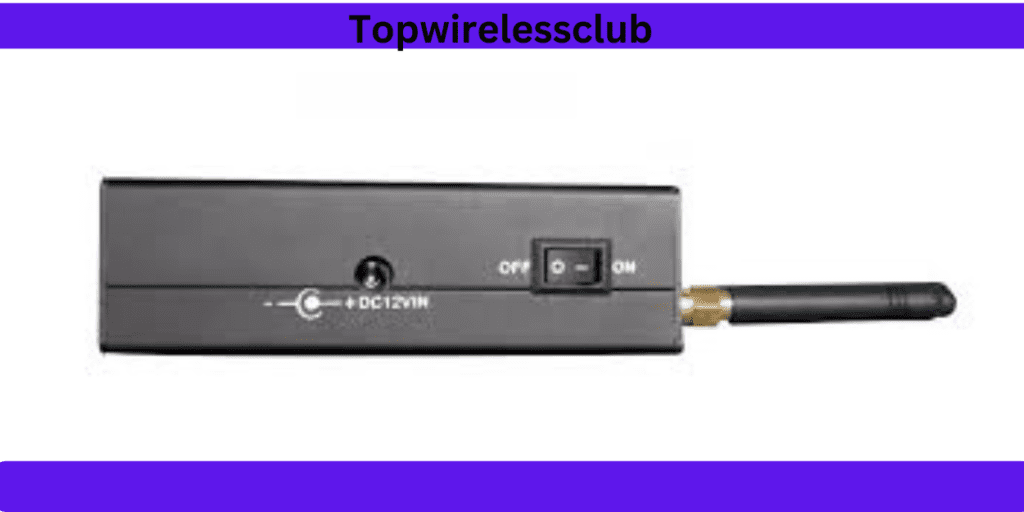To create a wireless camera jammer, begin by cutting a circular hole in the center of a can and covering it with mesh or screen. Next, connect a capacitor with a battery to attach to the can.
Jammers can effectively block spy and security cameras that rely on wireless LAN, wireless video and Bluetooth bands. However, be mindful that some jurisdictions prohibit using camera jammers, and if in doubt always consult local laws prior to attempting to build or use one.
Be careful and use caution when working with camera-jamming devices.

Introduction To Camera Jammers (CC Jammers)
Camera jammers are devices designed to block spy and security cameras operating on wireless LAN, wireless video, or Bluetooth bands. As privacy and security become ever more of a priority, camera jammers have become an indispensable way of safeguarding personal space and preventing unapproved video surveillance.
Explanation Of What A Camera Jammer Is
A camera jammer, as its name implies, is a device designed to disrupt the normal operation of cameras by emitting jamming signals in specific frequency ranges. These signals interfere with wireless communication between the camera and its respective receiver and prevent it from transmitting or recording video footage.
Importance Of Camera Jammers In Protecting Privacy
Camera jammers play an invaluable role in safeguarding against intrusive surveillance. As cameras become ever more ubiquitous both public and private spaces, having an effective means to block unwanted monitoring is becoming ever more vital. Camera jammers enable individuals to regain control over their personal space and protect it from prying eyes.
Brief Overview Of How Camera Jammers Operate
Camera jammers work by emitting disruptive signals within specific frequency bands used by cameras for wireless communication, effectively disrupting its signal transmission. By flooding its frequency band with interference signals from the jammer, its signal disruption causes malfunction in the camera preventing it from recording or transmitting video footage – effectively disabling it without physically harming it.
Materials and Tools Needed
Build your own wireless camera jammer using just a few materials and tools. Just cut a hole in the center of a can, cover it with mesh or screen material, and you are ready to block surveillance cameras that operate on wireless LAN, video and Bluetooth bands.
- Protect your privacy with this convenient device.
- List of Materials Needed for Building a Wireless Camera Jammer
- Tin cans, wire mesh screens and antenna wire are commonly found inside.
- Transmitter and receiver modules
- LED Light-Emitting Diodes (LEDs) use either batteries or AC adapters as power sources, which provides enough illumination for use indoors and outdoors.
Tools Needed for DIY Project
For creating a wireless camera jammer, the following tools will be necessary:
- Soldering iron: This tool is essential for soldering components together and creating secure connections.
- Solder wire: Used to form strong electrical connections between components, it helps ensure secure electrical interactions.
- Wire cutter: Used to trim wires to their appropriate lengths.
- Hot glue gun: Used to secure components into place and strengthen connections.
Use quality materials for reliable results:
Employing quality materials when creating a wireless camera jammer is key for reliable results and to ensuring its safe operation. Substandard components could perform poorly or pose safety risks; by investing in quality components you can create a jammer that successfully blocks wireless camera signals while operating efficiently.
Reliable materials are essential to the longevity of any DIY project. Substandard components could lead to your jammer malfunctioning prematurely; by investing in quality materials, you can ensure your wireless camera jammer continues performing effectively for years.
Step-by-Step Guide To Building A Wireless Camera Jammer
Making your own wireless camera jammer can be an invaluable way of protecting your privacy and thwarting any unwanted surveillance. Use this step-by-step guide to build one with minimal materials and circuitry requirements.
Step 1: Make A Hole For An Antenna In The Can
Start by finding a metal can similar to that used for soda beverages and, using a sharp utility knife, cutting a circular hole in its lid using an exact circle cutter. Be sure to ensure that this hole can accommodate an antenna for your jammer.
Step 2: Covering The Hole With Mesh or Screen
After making your hole, use adhesive or tape to secure a piece of mesh or screen just larger than it over it in order to keep debris out while still allowing your antenna to function effectively. This will prevent unwanted debris from entering and will help ensure its antenna can operate effectively.
Step 3: Assembling The Circuitry For The Jammer
Now it’s time to build the circuitry for your wireless camera jammer! Gather all of the required components, such as power source, oscillator and frequency mixer. Carefully follow any provided diagram or instructions in order to connect everything together correctly.
Step 4: Connecting The Antenna To The Circuit
Attach one end of your antenna to the output of a frequency mixer and make sure it is securely attached to the circuit board as any loose connections could compromise its effectiveness.
Step 5: Integrating The Circuit With The Can
Set the circuit board into the can, taking care to place its antenna through the hole in its lid. Use adhesive or tape to secure it firmly into place so it does not move or come into contact with any side walls of the can.
Step 6: Validating Your Camera Jammer
Before using your wireless camera jammer, it is crucial to test its effectiveness. Turn on the jammer and verify that all desired camera frequencies have been blocked successfully by it. Adjust settings or make necessary modifications if required in order to maximize its performance if necessary.

Usage And Considerations
Wireless camera jammers can be an invaluable way to protect both privacy and security, whether that means safeguarding personal space or maintaining confidentiality in a particular area. Understanding their usage and benefits is key.
Explained Here Is Why And Where A Wireless Camera Jammer Should Be Utilized
Wireless camera jammers should be used whenever there is a need to temporarily disable or block surveillance cameras on wireless LAN, wireless video and Bluetooth bands. Such jammers are particularly helpful in preventing unauthorised access or security breaches from taking place.
Legal Considerations and Restraints Relating to Camera Jammers
Before using a wireless camera jammer, it’s essential to understand all of its legal implications and restrictions. In many countries, owning or possessing such devices is illegal as they interfere with public safety and violate rights of other individuals.
Before considering using a camera jammer in your specific jurisdiction, it is imperative to do extensive research and understand its regulations. Violating them could have serious repercussions, including fines or legal action against you.
Tips For Optimizing Jammer Performance
Making sure your wireless camera jammer is effective requires careful planning and execution, here are a few tips that may help increase its efficacy:
Positioning: To effectively block camera signals, place the jammer strategically. Take time to evaluate the surveillance area and choose an optimal spot for optimal coverage.
Power Output: Make sure your camera jammer has enough power output to successfully disrupt wireless signals of cameras you wish to disable.
Frequency Range: Research the specific frequency bands utilized by wireless cameras that you wish to jam and select a jammer that covers those frequencies.
Patience and Persistence: While certain cameras contain anti-jamming protections, it may take time and persistence to find an approach or combination of frequencies which effectively disable them.
Jammer Detection: Keep in mind that some cameras come equipped with inbuilt detection systems capable of identifying jammers. To avoid raising suspicion and suspicion-raising actions by authorities, opt for discreet jammers that are hidden well.
By following these tips and adhering to legal regulations, you can make sure your wireless camera jammer is used responsibly and effectively in situations when privacy and security protection is needed.
Alternative Methods For Disabling Surveillance Cameras
Make a DIY wireless camera jammer by cutting a hole in the center of a can and covering it with mesh or screen material, this DIY device can help disable surveillance cameras and prevent unwarranted recording sessions.
Alternative Ways of Disabling Surveillance Cameras
Exploration of other techniques to disable or interfere with surveillance cameras.
Wireless camera jammers are an effective tool for disabling surveillance cameras; however, other methods exist. From physical obstruction to electromagnetic interference, each has its own benefits and drawbacks that should be considered when selecting the most suitable solution for your situation. Knowing all available alternatives will enable you to make an informed decision that suits best your circumstances.
Pros and Cons of Each Approach
- Physical Obstruction: One simple and low-cost way to disable surveillance cameras is through physical obstruction, such as placing curtains, fences or trees directly in their line of vision. Physical obstruction doesn’t require technical expertise or equipment – however it may only work against cameras with wider viewing angles than others.
- Glare Manipulation: Another effective method to disable surveillance cameras is manipulating glare to obscure its vision, which can be done using reflective materials or shining bright lights into the camera lens. Glare manipulation may make camera footage unusable but requires precise placement as it may not work against cameras with advanced glare reduction technologies.
- Laser Pointing: Another advanced approach involves using lasers to disable surveillance cameras. By pointing a laser directly at a camera lens, its concentrated light can overwhelm its image sensor and effectively blinding it. Laser pointing may even work from long distance, making it an effective option when physical obstruction is not an option. However, keep in mind that this practice may be prohibited in certain jurisdictions due to safety concerns and potential damage to camera equipment.
Compare wireless camera jammers in terms of effectiveness and ease of use
Wireless camera jammers offer more effective ways of disabling surveillance cameras than alternative methods do, as their purpose is specifically tailored towards disrupting the signals used by surveillance cameras to transmit video or audio footage, leaving them incapable of transmitting. They’re highly effective against a wide variety of cameras without needing physical access to disable them.
Wireless camera jammers tend to be the more user-friendly solution than alternative methods, as they can be operated with just the push of a button or switch, making them accessible even without technical knowledge. Whereas physical obstruction or laser pointing might require more manual effort and precise positioning – wireless camera jammers offer easier solutions.
FAQs
Do You Want To Learn How To Block Security Cameras Wirelessly?
Yes, jamming wireless security cameras is possible and criminals may attempt to disrupt Wi-Fi camera signals; it is therefore crucial that you understand the risks and take appropriate precautions in order to secure your surveillance system.
How Can I Disable My Neighbor’s Security Camera?
To obstruct your neighbor’s security camera, physical methods like hanging curtains or installing fences and barriers may be effective in blocking its view. Planting trees or barriers high enough can also work to block its view – but please keep in mind that any attempt at tampering with security cameras is illegal and should never be attempted!
Magnets may work to temporarily disable analog wired cameras, while IP and wireless cameras are more secure. Note that using a camera jammer is illegal.
Can A Magnet Disable A Security Camera?
No, magnets cannot completely disable security cameras, but they can disrupt video footage. Stronger magnets may affect analog wired cameras more than IP or wireless ones. Please remember that any attempted interference with security cameras is illegal, and magnets should only ever be used responsibly.
How Does A Wireless Camera Jammer Work?
A wireless camera jammer works by emitting jamming signals that block wireless links for surveillance cameras. It is typically handheld device equipped with a trigger to temporarily disrupt cameras before needing to recharge from its battery after short intervals.
Conclusion
Conclusively, making a wireless camera jammer is an effective and simple way to block spy and security cameras that rely on wireless signals. By following a few easy steps (such as cutting a hole in a can and covering it with mesh or screen), it can create a simple device capable of sending out jamming signals that disrupt wireless links.
Responsibility in using camera jammers responsibly is of the utmost importance, both within legal constraints and to protect privacy and security. By understanding how wireless cameras can be jammed, individuals can take measures to protect both themselves and their loved ones’ safety and privacy.
